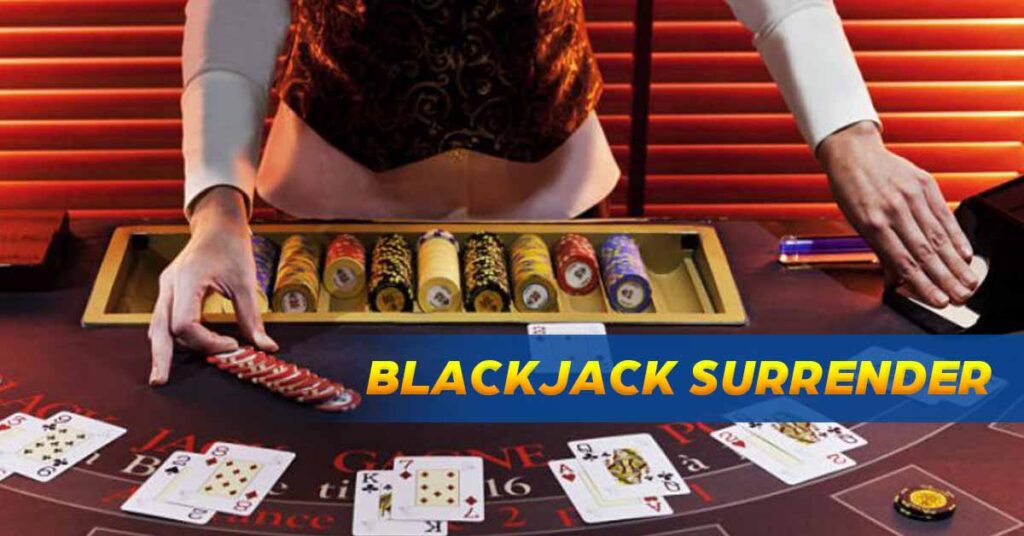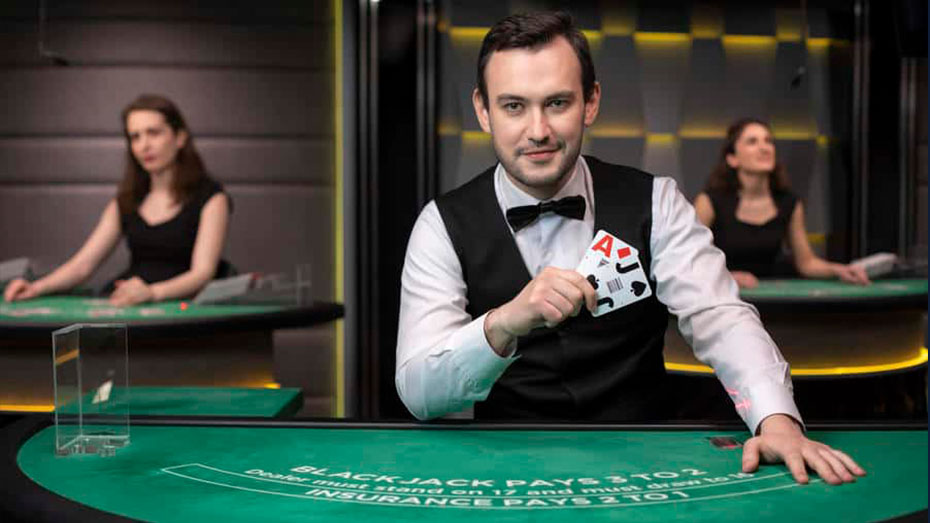Blackjack Surrender Strategy Explained
Playing Blackjack Surrender is quite similar to the standard version of Blackjack but with an exciting twist that adds an element of strategy and decision-making. If you’re familiar with traditional Blackjack, you’ll find the gameplay of Blackjack Surrender both intriguing and rewarding.

What is Blackjack Surrender?
Blackjack Surrender is like a safety net for players. Unlike traditional Blackjack, where you have to play out your hand no matter what, in Blackjack Surrender, you get the chance to fold your hand and recoup half of your bet. It’s like a “get-out-of-jail-free” card for gamblers. But remember, this option isn’t always the best choice. Let’s explore further.

How to Play Blackjack Surrender
Here’s a step-by-step guide on how to play Blackjack Surrender in online casino:

Step 1: Place Your Bet
To start, place your bet on the designated spot on the table. You’ll be dealt two cards face-up, while the dealer also receives two cards—one face-up (the “up-card”) and the other face-down (the “hole card”).
Step 2: Evaluate Your Hand
After receiving your two cards, take a moment to evaluate the strength of your hand. Just like in regular Blackjack, the goal is to get a hand value as close to 21 as possible without exceeding it.
Step 3: Consider the Surrender Option
This is where the “surrender” element comes into play. Take a close look at your hand and the dealer’s up-card. Depending on the version of Blackjack Surrender being played (Early or Late Surrender), you might have the option to surrender at this point.
Step 4: Decide to Surrender or Continue
Based on your evaluation, you can now decide whether to surrender or continue playing the hand. If you choose to surrender, you’ll forfeit half of your initial wager, and the round ends for you. This can be a strategic move when your chances of winning are slim.
Step 5: Play Out Your Hand
If you opt not to surrender, you’ll proceed to play out your hand. You can choose to hit (receive an additional card) or stand (keep your current hand). Regarding hitting, standing, doubling down, and splitting, the same guidelines that apply to standard Blackjack also apply here.
Step 6: Dealer’s Turn
Once you’ve made your decisions, the dealer reveals their whole card and plays out their hand according to predetermined rules. Generally, the dealer must hit until they have a hand value of 17 or higher.
Step 7: Compare Hands and Determine the Winner
After the dealer completes their turn, the hands are compared. If your hand value is closer to 21 than the dealer’s without exceeding it, you win. You lose if your hand value surpasses 21 or the dealer’s hand is closer to 21.
Step 8: Collect Your Winnings on Bets
Depending on the value of your hand and the payout chart for the exact Blackjack Surrender version you are playing, you will be paid out if you win the hand.
Step 9: Start a New Round
Whether you win or lose, the round concludes, and you have the option to place a new bet for the next round. The game continues with new hands being dealt to both you and the dealer.
The Two Versions of Surrender
In the world of Blackjack Surrender, there are two intriguing variations of the surrender option that add depth and complexity to the game: Early Surrender and Late Surrender. Each version comes with its own set of rules and strategies, offering players different ways to navigate the exciting realm of card gaming.

Early Surrender:
Early Surrender lets players give up their hand once the dealer evaluates their hole card, acting as a sort of safety valve. In other words, if you have a weak hand and feel like your chances of winning are slim, you can opt for early Surrender and get back half of your initial bet. This version can be particularly advantageous when facing a dealer’s strong up-card or unfavorable odds.
Picture this: You’re dealt a hand that doesn’t seem promising, and the dealer’s up-card is a formidable Ace. In this scenario, you might choose early Surrender to mitigate potential losses. This strategic move can be likened to folding in poker when the odds aren’t in your favor. By surrendering early, you cut your losses and live to fight another round.
Late Surrender:
Late Surrender, on the other hand, comes into play after the dealer confirms they don’t have a blackjack. This version adds an extra layer of decision-making to the game. Now, you have more information at your disposal—the knowledge that the dealer doesn’t have an unbeatable hand from the start.
Imagine you’re dealt a hand that’s decent, but the dealer’s up-card is strong. In this scenario, late Surrender gives you the chance to evaluate the situation with greater clarity. If you’re convinced that the odds aren’t in your favor, you can surrender at this point, recouping half of your bet and minimizing potential losses.
To Surrender or Not to Surrender?
The decision to surrender isn’t always clear-cut. It depends on factors like your total, the dealer’s up-card, and the version of Surrender in play. When your chances of winning are slim, surrendering can be a smart move. But don’t surrender just because you’re uncertain. Occasionally, making a calculated risk can result in success.

The Calculated Risk:
Surrendering isn’t about admitting defeat; it’s about making a calculated decision based on the circumstances. Imagine you’re dealt a hand that totals 15, and the dealer’s up-card is a 10. The odds aren’t exactly in your favor. Here’s where surrendering becomes a tactical move.
When to Surrender:
Weak Hand, Strong Dealer Card: As mentioned, when your hand is weak (usually totaling 15, 16, or 17) and the dealer’s up-card is high (10 or Ace), surrendering can minimize your losses. The chances of improving your hand might be slim, so why risk losing the entire bet?
Late Surrender Advantage: In Late Surrender, after the dealer checks for Blackjack, you have even more information to base your decision on. If the dealer’s hand looks strong and your cards aren’t promising, surrendering can help you recover half your bet and live to play another round.
When Not to Surrender:
Potential for Improvement: If you have a hand that can be improved through hitting (drawing another card), consider other options before surrendering. Sometimes, taking a hit or standing might lead to a better outcome.
Promising Hand: If your hand value is relatively strong, especially when compared to the dealer’s up-card, surrendering might not be your best move. In these cases, standing or even doubling down could offer better odds of winning.
Basic Strategy for Blackjack Surrender
In the world of Online Blackjack Surrender, a solid strategy can be your best ally. While luck certainly plays its part, having a well-thought-out plan can significantly enhance your odds of success. Let’s delve into the basic strategy that can help you navigate the exciting twists of this variant and make your gameplay more rewarding.

1. Know Your Hand:
Understanding the value of your hand is the foundation of any successful blackjack strategy. Whether you have a low-value hand that requires a hit or a strong hand that calls for a stand, knowing your hand’s potential is key.
2. Evaluate the Dealer’s Up-Card:
The dealer’s up-card can provide valuable insight into their potential hand. If the dealer’s card is weak (2 to 6), they have a higher chance of busting. In such cases, playing conservatively might be your best bet.
3. Embrace Surrender Wisely:
Remember, surrendering is a tool in your arsenal, not a sign of weakness. Utilize it when the odds are against you. If you have a weak hand and the dealer’s up-card is strong, surrendering can minimize losses and keep you in the game.
4. Hitting and Standing:
In general, if your hand value is 11 or less, always hit to improve your chances of getting a stronger hand. If your hand is 17 or more, consider standing to avoid the risk of busting. Between 12 and 16, your decision should be based on the dealer’s up-card.
5. Doubling Down:
Doubling down can be a powerful move, especially when your hand total is 9, 10, or 11. If the dealer’s up-card is weak, this is your opportunity to increase your wager and potentially double your winnings.
6. Splitting Pairs:
When you’re dealt a pair, you have the option to split them into two separate hands. Always split Aces and 8s, as these pairs can lead to stronger hands. Avoid splitting 10s, as a total of 20 is already strong.
7. Late Surrender Strategy:
In Late Surrender, take into account the dealer’s actions before surrendering. If the dealer’s hand is weak, consider playing out your hand to see if you can beat their total. If the dealer’s hand is strong and your hand is weak, Surrender might be the better option.
8. Practice, Practice, Practice:
The more you play, the more you’ll internalize the strategy. Consider using strategy charts, which provide guidance on every possible hand combination against different dealer up-cards.
In essence, the basic strategy for Blackjack Surrender revolves around making informed decisions based on your hand, the dealer’s up-card, and the version of Surrender in play. With practice, patience, and a strategic mindset, you’ll find yourself making better choices, minimizing losses, and increasing your chances of walking away from the table as a winner.
FAQs
Conclusion
With Blackjack Surrender, the familiar game takes on a new dimension. The option to surrender introduces a strategic element that can make a significant difference in your outcomes. Remember, it’s not about surrendering every time; it’s about making the right call at the right moment. So, step up to the table, embrace the uncertainty, and let the thrill of Blackjack Surrender sweep you away.




















